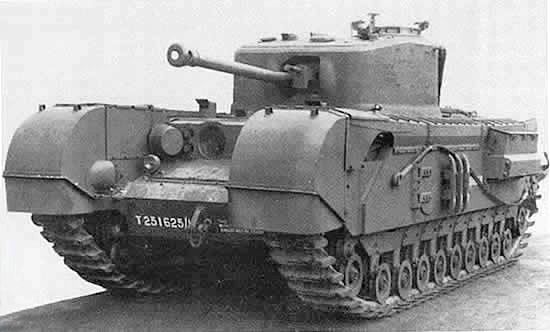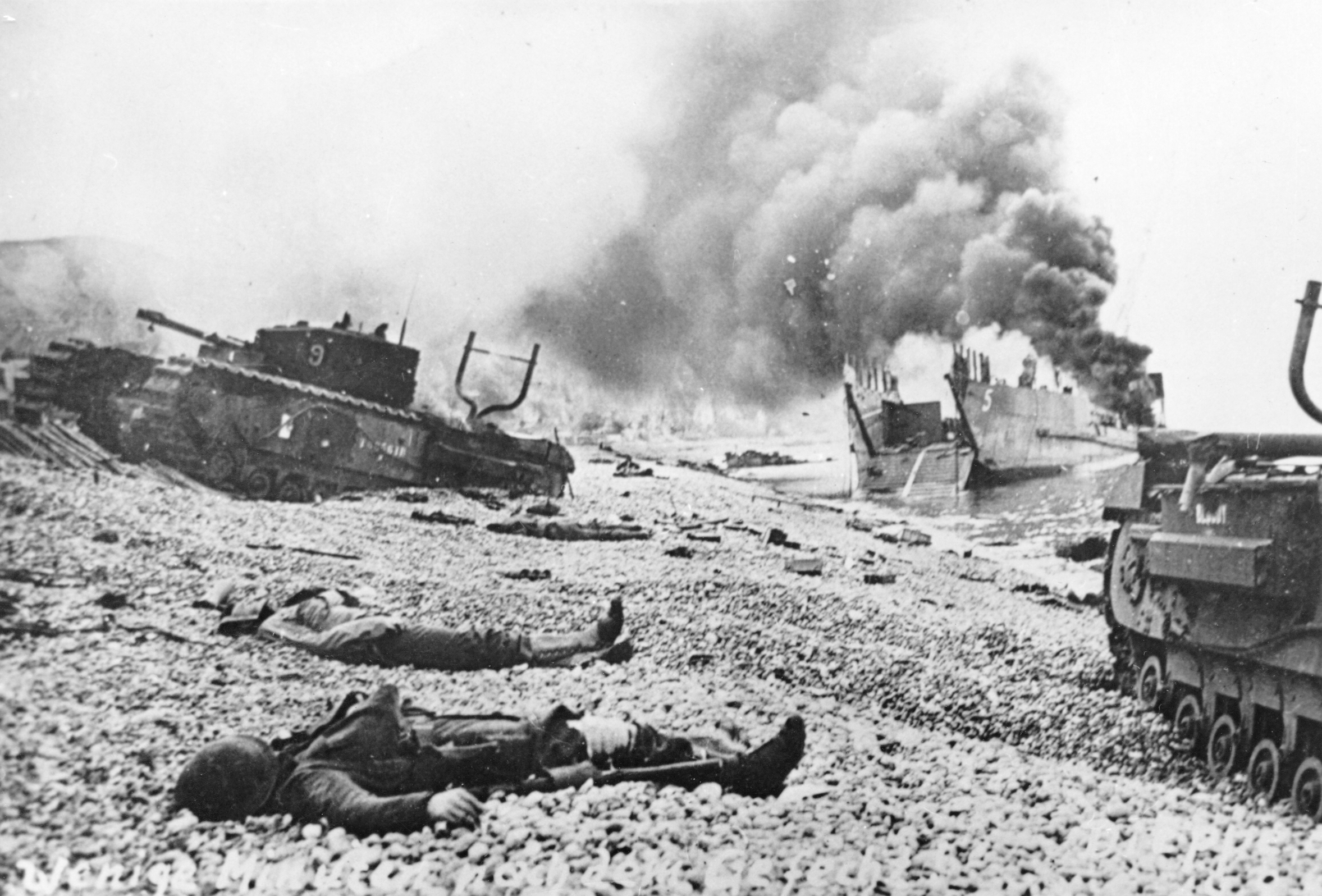That's a Churchill VII (thanks to Wikipedia)., although contemporary Ministry of Production documents refer to it as a "Heavy Churchill," a little judgmental given that it weighs in at 40,643 kg, compared with 39,118 for the original Churchill I. That's not heavy! It's just full bodied! And it's been working out! The front armour has gone from 102mm to 152mm. To put it in perspective, the thickest armour on the 70 ton King Tiger is 185mm --and the Churchill's armour is arguably of higher quality, but that's not an argument I want to get into. Not least because I probably need to revisit The Making, Shaping and Treatment of Steel before I make an idiot of myself with it.
The armour is compensated by the gun. The King Tiger has a particularly long version of the famed 88mm, while the Churchill's gun is another descendant of the Soixante-Quinze, basically meant to kill men in the open and winkle them out from behind field fortifications and gun shields, leaving the heavy can opening to siege artillery. That's because the armour is supposed to carry the Churchill into No Man's Land. It is heavy enough to stop any forward-sited anti-tank gun, and any of the friendly shells falling far enough short of their mission of suppressing the big enemy anti-tank and artillery.
One way of framing it is that the Churchill is a "support" tank. You could argue that the King Tiger is different and better because it is a "gun tank," but, really, it has the same role, only with a defensive twist that implies that it is going to fight Churchills --hence he bigger gun, and the heavier gun that goes with it and makes it less deployable, hence less suitable for attacks.
So that's the "heavy" Churchill. It's a support tank, and it is going to be supporting a beach attack in ten days, and it needs to be heavy. The Germans have seen "light" Churchills, and they did not have much trouble with them.
(Gruesome picture after the break.)
With its Merritt-Brown transmission and extra-long suspension, the Churchill ought to have been just the ticket for the shingle beach and sea wall at Dieppe. Notwithstanding the picture above, the fact that 15 of 29 crossed both obstacles and reached the anti-tank obstacles on the promenade suggests that the Churchill was alright mechanically. The issue was the inability of the tank to carry the assault by itself. Sappers were needed to clear the obstacles, and artillery to keep enemy fire down. Given that, it might not be a bad idea to up the front armour so that increasingly powerful front-area German antitank weapons (hint: not 88s) do not pick off the tanks supporting the sappers before they clear the obstacles.
None of this was news to the British Army. The World War I Tank Corps had been dominated by Royal Engineers at the higher ranks, and both Commandant Colonel Hughe Elles and chief of staff Major Giffard Martel promoted the development of "engineer tanks" to support the main force.
Those are not actually engineer vehicles, just regular Mark IVs, but they do point to one interesting feature that advantaged the tanks of World War I over those of the next war in that role.
As Martel writes, blowing up obstacles is hard to do from inside a tank. If sappers are going to go into battle with the tanks, why not put them in a tank? Then you only have to add a forward-opening armoured door on the side of some tanks, and the sappers will be able to do their job under cover! The bizarre sponsons mean that there are cuttings through the hull and suspension for this, and, in his 1935 monograph, In the Wake of the Tank, Martel recommends this automotively-challenging feature for a new generation of (support) tanks.
Sure enough, the Churchill has just such a door, and development of the Churchill into the first AVRE ("Armoured Vehicle Royal Engineer") followed straightforwardly from the design. The transmission, with its zero-radius turn capability, helps. The last think you want in a bulldozer is a big turning radius!
I have stressed Martel here to underline the fact that the Churchill AVREs are not some kind of novel brainstorm, and also because, given that you will probably have heard of them as 'Hobart's Funnies," this is a good place to underline the historical injustice perpetrated by Basil Liddell Hart, Percy Hobart and Bernard Montgomery. It is not even a matter of ten years intervening. Hobart actually took over Martel's job in 1943! Most of the famed "Funnies" of 79th Armoured Division have their origins in Martel's period as Commandant of the Royal Armoured Corps. (Of course, that means that he has to wear the goofy Canal Defence Light, too.)
Not that the point of this posting is the Churchill, or the 79th Armoured Division. Armoured warfare in Normandy is going to take a great deal more unpacking than a single, daily posting. All that I am pointing out here is that this is not some kind of outlandish idea from left field. The United States Army saw the need and fiddled around with engineering vehicle variants of their standard M4 Sherman. Plenty of "tankdozer" Shermans and armoured bulldozers were intended to land on D-Day (310ff), and many did. It is more-or-less the technical issues --the transmission, the armour, the lack of side doors-- and not the conceptual role that is at issue.
Those are not actually engineer vehicles, just regular Mark IVs, but they do point to one interesting feature that advantaged the tanks of World War I over those of the next war in that role.
As Martel writes, blowing up obstacles is hard to do from inside a tank. If sappers are going to go into battle with the tanks, why not put them in a tank? Then you only have to add a forward-opening armoured door on the side of some tanks, and the sappers will be able to do their job under cover! The bizarre sponsons mean that there are cuttings through the hull and suspension for this, and, in his 1935 monograph, In the Wake of the Tank, Martel recommends this automotively-challenging feature for a new generation of (support) tanks.
Sure enough, the Churchill has just such a door, and development of the Churchill into the first AVRE ("Armoured Vehicle Royal Engineer") followed straightforwardly from the design. The transmission, with its zero-radius turn capability, helps. The last think you want in a bulldozer is a big turning radius!
I have stressed Martel here to underline the fact that the Churchill AVREs are not some kind of novel brainstorm, and also because, given that you will probably have heard of them as 'Hobart's Funnies," this is a good place to underline the historical injustice perpetrated by Basil Liddell Hart, Percy Hobart and Bernard Montgomery. It is not even a matter of ten years intervening. Hobart actually took over Martel's job in 1943! Most of the famed "Funnies" of 79th Armoured Division have their origins in Martel's period as Commandant of the Royal Armoured Corps. (Of course, that means that he has to wear the goofy Canal Defence Light, too.)
Not that the point of this posting is the Churchill, or the 79th Armoured Division. Armoured warfare in Normandy is going to take a great deal more unpacking than a single, daily posting. All that I am pointing out here is that this is not some kind of outlandish idea from left field. The United States Army saw the need and fiddled around with engineering vehicle variants of their standard M4 Sherman. Plenty of "tankdozer" Shermans and armoured bulldozers were intended to land on D-Day (310ff), and many did. It is more-or-less the technical issues --the transmission, the armour, the lack of side doors-- and not the conceptual role that is at issue.
Does that mean that the US Army was dumb? The answer, of course, is that they are not. The Army has already thrown over a French design (the CharB) with the potential to be a good AVRE. Back in 1940, they were actually going to make the French tank. After all, the French Army was pretty good at that whole Army thing (let's not have that argument right now), and French engineers and liaison officers don't have that damn accent. The one that makes you feel dumb and makes you resent your high school. It had a good football team! God, I'm using the wrong spoon on my hot gazpacho, aren't I?
After the Char B project fell apart, the army's automotive engineers began fiddling around with electrics and hydraulics and whatnot, all with the aim of fielding the M6 tank, a big, heavy, slow infantry support tank with all the proper arrangements that go into a proper engineering vehicle. It just didn't go anywhere.
After the Char B project fell apart, the army's automotive engineers began fiddling around with electrics and hydraulics and whatnot, all with the aim of fielding the M6 tank, a big, heavy, slow infantry support tank with all the proper arrangements that go into a proper engineering vehicle. It just didn't go anywhere.
You might well ask why the British couldn't spare any of their Churchills. With over 7000 built, most by June of 1944, the case could be made that there was not much point in saving them for later if the Normandy landings failed.
This case was made. But there were not enough Churchills to go around. There's a reason for that, but at this point we are deep into an industrial history of the Normandy Campaign. There are a lot of strings I need to pull together to make my case, and I am not going to do it here. D-Day was the biggest and most complicated human project ever, and this series is supposed to show just what that means. For now, it means that 1st and 29th Infantry Divisions (notice that Omaha is not just the most costly of the five beach assaults, but also the biggest) is going to go in without AVREs.



No comments:
Post a Comment